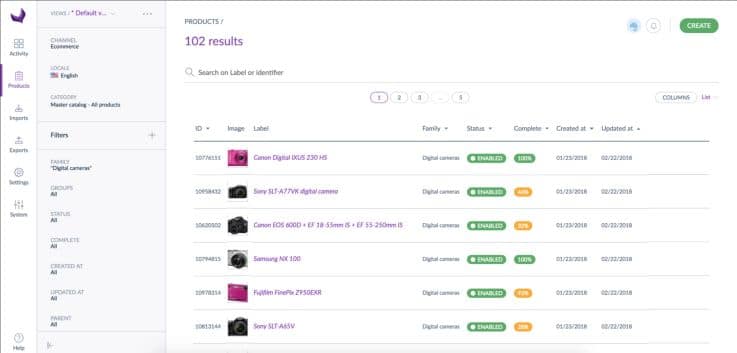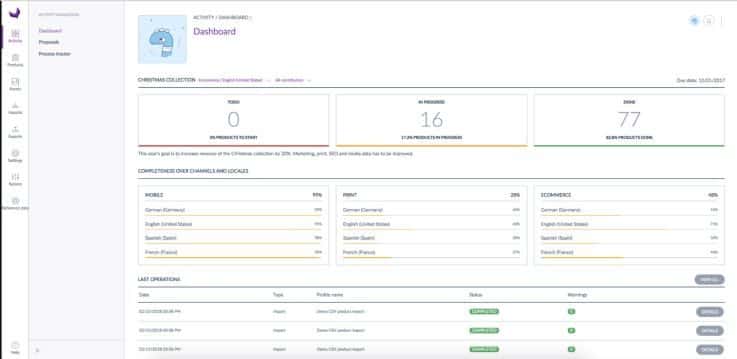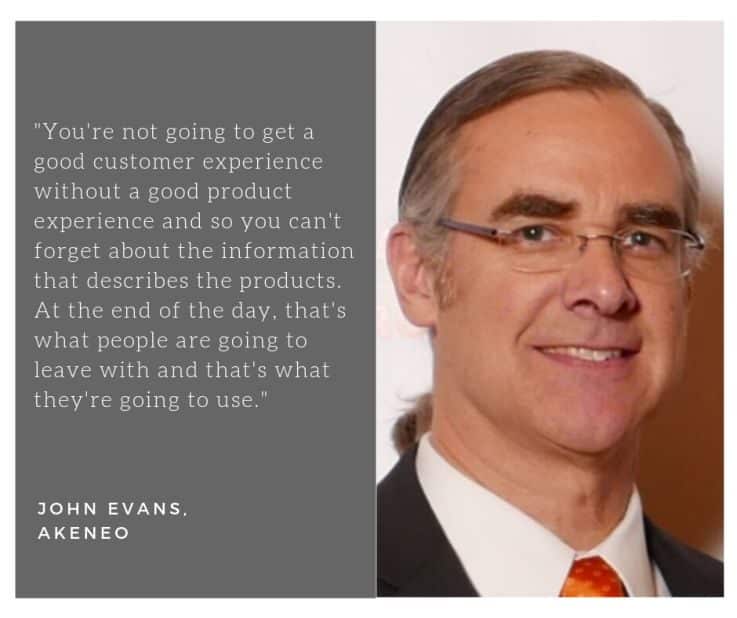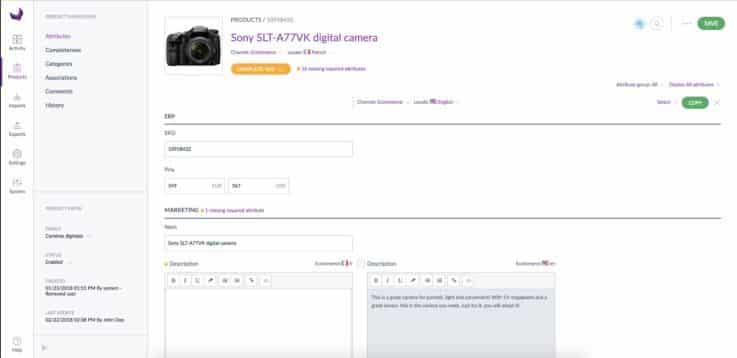Why Akeneo believes AI is the future of PIM solutions

If you work in retail, then you probably know the importance of having a good product information management (PIM) system. This valuable tool helps brands make sure that their information is correct across the board, which in turn helps enhance the customer experience.
As a leader in PIM solutions, Akeneo is always looking for ways to make its systems work harder for retailer. Its newly developed AI technology, Franklin, is the latest example of this.
We spoke to product marketing director John Evans about the suprising benefits a PIM system can have on retailer operations and what new capabilities AI brings to the PIM world.
John Evans, Product Marketing Director, Akeneo
Can you tell us about Akeneo?
Akeneo is the number one open-source enterprise product information management (PIM) system. The Akeneo PIM is a business application that’s designed for marketers to use to collect, enrich, standardise, put into context and then distribute, product information for items that are sold on ecommerce sites, mobile applications, marketplaces, print catalogues, in-store and so forth.
It’s an environment that’s set up to categorise your products and keep track of all of the interesting information about them. There’s technical information, which is facts like the weight, the size, the colour, what it’s made of etc. Then there’s usage information where you might talk about how somebody can benefit from the product and how they could use it. The third piece of information is emotional information where you create a connection with your buyers by writing contextual product descriptions or including images that show something in context.
One example would be if you were trying to sell something like a bedspread. A photo of it folded up will let you see what colour it is and the texture of the material. But a more emotional image might be a picture of a bedroom with that bedspread on a big bed with matching pillows, so customers can see what this product might look like in their home.
The way people manage product information today is a challenge and this is the reason why PIM tools exist. A lot of this information is in multiple places – an ERP system, a marketing database, supplier information etc. You typically end up with this collection of spreadsheets that people have used to manage all this data. There’s no workflow, there’s no governance.
A tool like Akeneo PIM is designed to bring order to that chaos and provide a common place to define your catalogue, your categories and how things relate. You can create a workflow and make that whole process trackable.

Why is Akeneo largely open source?
One reason is because it’s more transparent. We started with a community edition of our product that’s free to use. We also offer an enterprise version that has some additional features like Franklin that we charge a subscription fee in order to use.
It allowed us to get further adoption, to be more open and to serve more people, even those smaller outfits who didn’t have the budget to buy a PIM but still have a need to manage product information. It’s also allowed us to expand our ecosystem of partners. We have a marketplace on our website where we’ve got a pretty wide variety of extensions and integrations that have been created by technology partners and other contributors from the community.
This allowed us to add more capabilities to the product that much faster. Customers can use Akeneo and then they can extend it as they see fit by using the open source. The benefit of that compared to a proprietary solution is that you’ve not got to wait for the vendor to prioritise and get around to adding your capability – with open source you have capabilities to be able to do it yourself if you want.
What impact has the PIM had for your customers?
In general, with the Akeneo PIM our customers have told us that they are seeing an increase in their conversions, by as much as 50%, through having more consistent, accurate, complete and comprehensive product information. We’ve had a couple of customers tell us that they’ve seen their conversion rate increase three or four times.
The other benefit is typically a reduction in returns. Customers have said they’ve seen up to a 40% reduction in returns. This follows logically because if you know what you’re buying and you’re confident, and then you buy it and it’s exactly what the website said it was you’re likely to keep it. If it’s not, then you’ll more likely to return it.
Our customers also often talk about productivity increases for their catalogue management team. They might be 70% more productive in terms of processes because something that used to take a week now takes a day because they’re not having to fumble about with a hairball of spreadsheets.
Can you tell us when you brought the Franklin AI in and what it adds to the process?
If you think about the process of getting product information, from a retailer’s point of view sometimes that’s a real struggle. Sometimes manufacturers or suppliers don’t provide complete information. Retailers might have to go out looking for it, which is a costly, manual process to go through.
With Franklin, we applied a machine learning technology to the product data enrichment process. We have a curated library of product pages that we make available to companies using our PIM where they can retrieve product information from our sources to help them deliver a gold record of the technical product data.
We get the data from sources on the internet. We have a scoring methodology that decides if the sources are trustworthy or not and we validate the different attributes that are coming in. We can ascertain through our machine learning technology if we think this is accurate, reliable data and then we’ll present that to the PIM client and say ‘here’s some information that you may not have that you can use to populate your catalogue’.
What we’re doing over time is adding more product data intelligence capabilities to it to help users figure out what is the right way to present each product, and make recommendations, so that products are more easily found and shoppers will have a better product experience when they’re interacting with the ecommerce site.

Can you give us an example of this?
If you were shopping online for something that has a lot of attributes like a computer, you might go to a website, put in the features that you really care about, select two or three options that you might be interested in, click the compare button and what you get back is a grid of product information.
Those products are along the top and then each of the rows is a product attribute, eg how much RAM it has. Sometimes you’ll see that some of the products have all the attributes filled in and some of them are missing some. Sometimes with certain products the supplier doesn’t actually have all that information, so somebody has to manually add it to a site.
Our tool helps find that information and then tries to validate it, so that the retailer has the best information about the products and can deliver a better product experience that means shoppers are more likely to buy.
One of the benefits of this capability is it helps these retailers enrich their product information at scale and standardise all that technical data. With our subscription capability, you can automatically get any updates to that product information should it change, or should we discover new information about that product.
The other thing is that suppliers may have information about products on their website, but they don’t always keep it there for the older models. We would have that information archived in our product pages and we’d be able to make a better-quality source for the retailer.
Can you tell us a bit more about the product experiences that it helps craft?
The number one thing people are looking for when they’re shopping on the internet is price and then the rest of it is about product information.
A lot of the stuff you read about in retailing is all about customer experience and is it easy to buy? Can they buy online and pick-up in store? Can they buy online and return in store? Is it one-touch shipping and one-touch payment? Our angle on it is really around the product side of things. If you have all of these things, but people aren’t able to find your product, or they find your product and you’ve only got one sentence describing what the product is and you’ve got an incomplete set of product details and technical information, or you just have one picture and it’s not really meaningful, people aren’t going to buy because they don’t understand.
Our contention is you’re not going to get a good customer experience without a good product experience and so you can’t forget about the information that describes the products. At the end of the day, that’s what people are going to leave with and that’s what they’re going to use. If the product information is missing or incomplete or not compelling, as a retailer you will potentially lose out to somebody who’s doing a better job at that. From a supplier point of view if your products aren’t properly described on these retailer sites then you’re potentially going to lose to an alternative product.
In the most recent release of the product, we added in the capability to add a reference entity. For example, if I am a retailer working with a famous fashion designer, I might want to have some information about the designer on the webpage talking about their collection. That data is not typically considered product information but it’s relevant to creating that experience that you’re going to have when you go visit that site.
We can also extend that to things like the care instructions or the colours. You only have to define that characteristic once, but then you can apply it to different items. If you’ve got multiple shades of red, for example, you define those and then you start applying them to other products that use that shade or come in that shade. It further expedites the whole process for the catalogue manager.

Managing that kind of information in Akeneo PIM is contributing to helping craft a better and more fulfilling shopping experience than just seeing one image and a short product listing. Customers don’t then have any context for how their life will be different from buying that product.
The simplest thing is just translations. You might build your catalogue in English, but you want to get it translated into French and into German and so on. That can all be done inside the PIM using translation tools, but we would then calculate whether the information is complete for each locale taking into account each channel in that region. It might be that we need to include special attributes about the product or manage standards around sizing in different countries.
The other part is making sure that you’re cognizant of what channel the person is operating in or what locale they’re operating in. If somebody is buying through a print catalogue, they’re not going to be able to see a 360-degree video of the item, but you might want to have that on an ecommerce site. Or you might be selling in a locale where the way we depict products in use is different to other countries.
As an example, if you’re selling something like a dust mask that you wear over your face, in the US we might have a picture of that item, but in China they want to make sure that you can see a picture of somebody actually wearing it. The imagery of that product includes somebody’s head with the mask on their face and it’s not necessarily the way it would be shown in another region.
It’s those cultural things that you might want to include. The other thing is that maybe you want to collect regulatory information or other required information that needs to be put on products according to whatever the local laws are.
We call that putting the data into context. Having that contextual data is part of what the product data intelligence is going to help with. The library helps us make sure that we’ve got complete, accurate and consistent technical information for those items. It’s all about trying to make yourself stand out and rise above the crowd and making sure that customers are having a better experience during the shopping process on your site or with your products.
Do you have plans to add extra features?
We view the Franklin capability as the cornerstone for our product data intelligence offering, so we’re going to be adding more analytical capabilities to help customers make sure that they are providing the best possible information.
We want to get an understanding of what their data set looks like and then help suggest how to best describe the product eg ‘here are some things you might include’ or ‘here are some attributes that you don’t have in your catalogue at the moment.’ Those are the kinds of things where we’re looking at.
Images courtesy of Akeneo
Want more? Check out our complete guide to AI in retail for everything you need to know about this growing technology. Want to quickly and easily connect with the players kick-starting trends and inventing the future of retail? Find out how you can transform your team’s thinking using Insider Trends’ little black book here.



